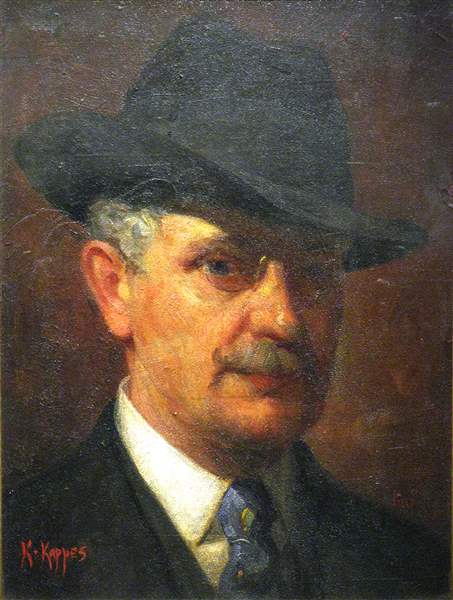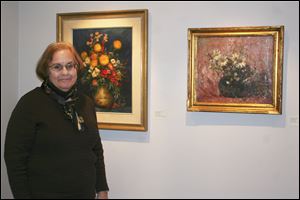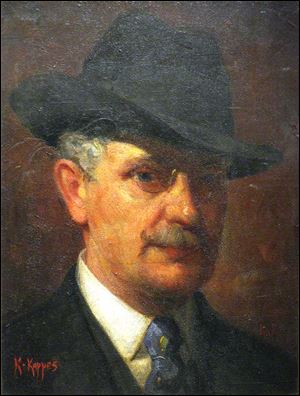
KARL KAPPES: OHIO PAINTER, 1861-1943
Ohio museum celebrates work of late Toledo artist
12/25/2011
Self-portrait of Karl Kappes.

Susan Talbot-Stanaway, director of Zanesville Museum of Art , showcases artwork by Karl Kappes.
ZANESVILLE, Ohio — His passion for painting burned so hot, it fueled two roundtrip walks from Ohio to New York City, three stints studying in Europe, and 62 years of intense creativity and teaching.
Karl Kappes, born to German immigrants in Zanesville six weeks after the first shots of the Civil War were fired, liked to quote a Chinese saying that no man is an artist until he’s painted 10,000 pictures.
"I am an artist," he would then declare.
We’ll never know whether his grand claim was true, but he churned out oils, watercolors, and pencil drawings until he died in 1943 at 82 in his crammed, walk-up apartment/studio at 1822 Adams St. in Toledo. Still in the studio six years later, his widow said, "How can a person be lonely when she has more than 2,000 paintings to keep her company?"
Kappes’ productivity, along with an enduring appreciation for his talent, has earned him a berth among the region’s best artists. Fifty of his pieces are displayed in Karl Kappes: Ohio Painter, 1861-1943, through Jan. 28 at the beautiful Zanesville Museum of Art, 190 miles southeast of Toledo.
Museum director Susan Talbot-Stanaway said she decided to build the show because she draws on the museum’s collection as a starting point for exhibits, and it owns about 43 works by the artist. It is the 150th anniversary of Kappes’ birth. Moreover, dozens of people in the area share his name; three Kappes [pronounced KAP-pes] families emigrated to Zanesville from Germany in the 19th century, she said.

Self-portrait of Karl Kappes.
In August she put a notice online saying the museum was planning to feature him, and was amazed when 20 people responded. From nine collectors, she borrowed pieces representing different periods and styles.
"We ended up with a lot more paintings than we thought, so the show expanded to two landings, a hallway, and the gallery," said Talbot-Stanaway, who’s in her seventh year as director. The last time the Zanesville museum had a solo Kappes show was in 1945.
Study in Munich
Tall, handsome, athletically built, and one of 12 children, Kappes was the valedictorian of his high school class. He studied in Cincinnati and then with the celebrated American artist William Merritt Chase, whose famous New York City atelier was a magnet for young artists. Chase had learned traditional painting at the Royal Academy in Munich, as had many other Americans. Kappes, 12 years younger than Chase, determined to do the same, and at 20, 22, and again at 28, with modest help from his parents, he sailed for Germany, throwing himself into intense study at the academy that had hundreds of pupils from the United States and Europe.
In letters to his parents, he described his spartan lifestyle, assuring them he was working hard and being frugal.
"At school I am drawing a half-nude figure of a man and when finished will get it photographed and send home a copy. The professor likes it very much and praises me every time he sees it," he wrote in March, 1884. "For the short time I have been in the nature class the students think I have made remarkable progress."
His Munich portraits were excellent examples of what he was taught: realistic images of women and men, with particularly fine renderings of eyes, foreheads, and noses. As the best portraitists do, he was able to impart something of the individual’s personality, a quality that engages the viewer.
Returning to Zanesville, he taught art. And at Weller Pottery, one of several companies in town that used its abundant clay soil to make decorative pottery, he created designs and taught staff artists. He wedded a beautiful milliner who brought children to the marriage, a fact he did not consider an asset.
By 1912, he moved to Toledo, but it’s unclear whether it was a full-time move and whether he divorced his wife. He spent summers in a country home in Texas, Ohio, along the Maumee River, where he created a lavish garden in the Henry County hamlet about 33 miles southwest of Toledo. An artists’ colony developed there, and on summer weekends, up to 100 people, mainly from Toledo, would drive out for lessons, painting in the fresh air, and Sunday potlucks.
"I had a little trouble at first, getting myself trusted in the town," he was quoted in a 1929 Toledo Times article. "I wore a khaki suit and went about sketching which was enough to arouse the neighbors’ worst suspicions. They thought I was a prohibition agent doing painting as a blind."
The late Vardinique North, the widow of Earl North, one of Kappes most well-known students, spent summers at her grandparents’ home in Texas across the garden from Kappes’ studio. "In the summer, it seemed there was a painter for every tree in Texas," she once told The Blade. She said her grandmother had her deliver apple pies to Kappes and Wilder Darling, another Toledo artist who had also studied painting in Europe and was invited out to paint with Kappes.
‘Mrs. Kappes’
In 1916, Elizabeth Greiner of Blissfield sought his opinion on a painting: he determined it was by a prominent 14th century artist and sold it for a profit. She was 46; he 55. They became devoted partners; she learned to restore old paintings and was his most exacting critic. His students and friends called her Mrs. Kappes until her death at 90 in 1960, but it’s not clear they married.
In November, 1943, he had a heart attack at home, and an hour before he died, she and two of the couple’s friends said Kappes told them he was sorry he hadn’t written a will but wanted her to have everything. The deathbed will was upheld. In 1951, at the age of 81, she sold most of his paintings at the Adams Street studio.
His style had changed dramatically from the traditional realism he’d learned in Munich to a self-taught impressionism, for which he loaded his brush with a bright palette and made short, thick strokes.
At first, Talbot-Stanaway figured Kappes to be a rather average regional painter until she visited the homes of collectors to borrow his work.
"I saw his paintings on their walls next to other painters, and I could see how much more sophisticated and interesting he was," she said.
Lionel McIlwain has bought Kappes works since 1969 and says he is underappreciated, as are many regional painters, partly because his address was Toledo, not New York.
"There’s too much of that attitude [about regional artists]," said McIlwain, a Sylvania Township collector, antique dealer, and estate liquidator with his wife, Coral McIlwain. "I was able to buy some fairly significant works relatively inexpensively."
He’s paid as much as $900 for a Kappes and sold them for up to $3,000.
"His quality varies a lot," probably reflecting the attention he invested in the piece, said McIlwain. "When he wanted to, he could do absolutely outstanding work."
‘Meditation’
Kappes considered his masterpiece to be a portrait of a sharp-featured older woman, weary or wistful, seated and leaning forward, head in hand. He called it Meditation; he was 20 when he painted it in 1881 in Munich.
"It’s very, very well done. He put a lot of effort into it. And the expression is wonderful too," said McIlwain. "And some of his landscapes are pretty amazing."
Jean Chapman regrets selling a painting Kappes did of his mother.
"I fell in love with him and this painting. I just sensed that he was an artist to the core," said Mrs. Chapman, who exhibited his work in 1976 at the Sylvania studio she ran with her husband, painter Walter Chapman. She had purchased many of Kappes’ works for less than $20 at a house sale.
The late Blade art editor Louise Bruner wrote of the Chapman display: "While Kappes was neither a profound painter nor an innovator, he produced well-made pictures of the world he knew, and his optimistic, personal vision still makes them a pleasurable experience."
Said Mr. Chapman: "He didn’t paint so you would think it was cute or admire his brush strokes. He wanted you to admire the painting."
"I heard he was a wonderful, wonderful teacher," said Mrs. Chapman. "Earl North was probably his most famous student."
John McCarthy, a South Toledo collector and dealer specializing in regional art, agreed.
"Kappes was probably the most influential of the better Toledo artists: he had the most students," said McCarthy, noting that there are probably many Kappes paintings in private homes. "I guess he was a character as a teacher." Stories linger about Kappes standing behind a student’s shoulder, encouraging her or him to paint like him.
"His portraits are just gorgeous," McCarthy said. He’s seen the lovely one Kappes did of his mother, but observed that while it’s wonderfully painted, buyers are more likely to prefer one of the artist’s impressionistic landscapes.
Contact Tahree Lane at: 419-724-6075 and tlane@theblade.com.